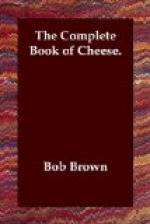Romano is not as expensive as Parmesan, although it is as friable, sharp and tangy for flavoring, especially for soups such as onion and minestrone. It is brittle and just off-white when well aged.
Although made of sheep’s milk, Pecorino is classed with both Parmesan and Romano. All three are excellently imitated in Argentina. Romano and Pecorino Romano are interchangeable names for the strong, medium-sharp and piquant Parmesan types that sell for considerably less. Most of it is now shipped from Sardinia. There are several different kinds: Pecorino Dolce (sweet), Sardo Tuscano, and Pecorino Romano Cacio, which relates it to Caciocavallo.
Kibitzers complain that some of the cheaper types of Pecorino are soapy, but fans give it high praise. Gillian F., in her “Letter from Italy” in Osbert Burdett’s delectable Little Book of Cheese, writes:
Out in the orchard, my companion, I don’t remember how, had provided the miracle: a flask of wine, a loaf of bread and a slab of fresh Pecorino cheese (there wasn’t any “thou” for either) ... But that cheese was Paradise; and the flask was emptied, and a wood dove cooing made you think that the flask’s contents were in a crystal goblet instead of an enamel cup ... one only ... and the cheese broken with the fingers ... a cheese of cheeses.
Pont L’Eveque
This semisoft, medium-strong, golden-tinted French classic made since the thirteenth century, is definitely a dessert cheese whose excellence is brought out best by a sound claret or tawny port.
Port-Salut (See Trappist)
Provolone
Within recent years Provolone has taken America by storm, as Camembert, Roquefort, Swiss, Limburger, Neufchatel and such great ones did long before. But it has not been successfully imitated here because the original is made of rich water-buffalo milk unattainable in the Americas.
With Caciocavallo, this mellow, smoky flavorsome delight is put up in all sorts of artistic forms, red-cellophaned apples, pears, bells, a regular zoo of animals, and in all sorts of sizes, up to a monumental hundred-pound bas-relief imported for exhibition purposes by Phil Alpert.
Roquefort
Homage to this fromage! Long hailed as le roi Roquefort, it has filled books and booklets beyond count. By the miracle of Penicillium Roqueforti a new cheese was made. It is placed historically back around the eighth century when Charlemagne was found picking out the green spots of Persille with the point of his knife, thinking them decay. But the monks of Saint-Gall, who were his hosts, recorded in their annals that when they regaled him with Roquefort (because it was Friday and they had no fish) they also made bold to tell him he was wasting the best part of the cheese. So he tasted again, found the advice excellent and liked it so well he ordered two caisses of it sent every year to his palace at Aix-la-Chapelle. He also suggested that it be cut in half first, to make sure it was well veined with blue, and then bound up with a wooden fastening.




